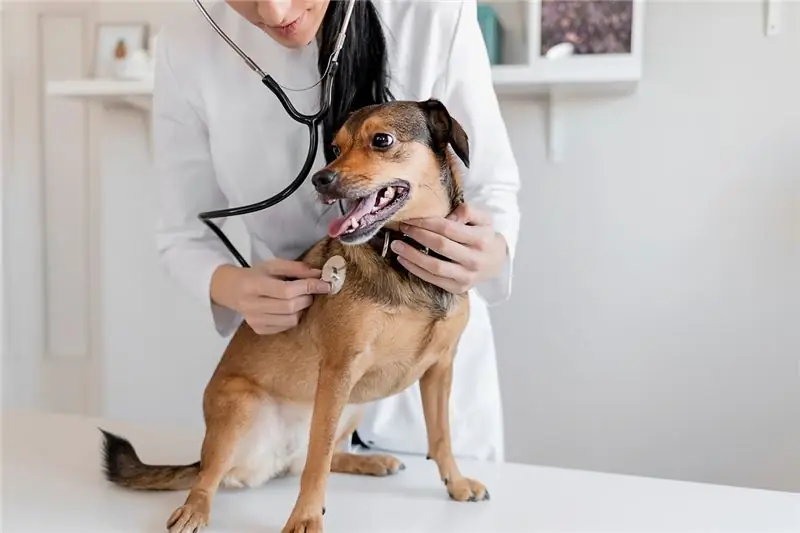
- Autor Daisy Haig [email protected].
- Public 2023-12-17 03:06.
- Zadnja izmjena 2025-06-01 06:47.
Pa čemu uopće služi taj sramotni test caca?
Dovoljno je stresno da stražnji dio vašeg ljubimca naruši plastična šipka, zar ne? Pa u čemu je poenta?
Kažete: Ako je cilj učiniti svog ljubimca zdravijim i bez parazita, tada ću vjerovati vašoj prosudbi, ali moram reći da su provjere stolice vrsta okrutne i neobične kazne. Takvu vrstu poniženja ne dobivam dok nemam muško i četrdeset godina, zar ne? A fekali nisu toliko korisni, zar ne?
Kažem: za početak, vaš ljubimac ne treba podleći podloj štapu. Svježi uzorak obično se lako dobije ujutro (ili popodne) prije vaše godišnje posjete ili u bilo kojem trenutku kada vaš ljubimac pati od gastrointestinalnih simptoma. Nije tako teško, stvarno. A ako vrijeme nije točno (stolica ne bi trebala biti starija od sat vremena za najbolje rezultate), vaša veterinarska bolnica vam sigurno neće uskratiti pravo da unesete super svježi uzorak po vašoj želji. Obećaj.
I da, fekalni pregledi, iako relativno jeftini i rutinski, neophodni su. Ali kao što će pokazati ovaj post, istina je i da neće svi fekalni testovi pokupiti infekciju parazitima kod vaših kućnih ljubimaca. Zbog toga mogu biti potrebni godišnji i / ili serijski fekalni pregledi.
Sada primarni cilj testa:
Veterinari su uvijek u potrazi za parazitima koji se mogu naći u gastrointestinalnom traktu vaših ljubimaca. Svakako, i mi ljudi možemo dobiti parazite, ali naš moderni način života obično manje pogoduje zarazi parazitima. (Kada ste zadnji put šmrkali u dvorištu, usana na zemlju, samo da biste mogli udahnuti mačju grmulu ili dvije?)
Da, kućni ljubimci dobivaju puno parazita. Evo uzorka najčešćih gastrointestinalnih parazita koje ovdje vidim [na nebu parazita, koje je polu-tropska Južna Florida]:
Okrugli crvi kod pasa i mačaka.
Hookworms u kućnih ljubimaca
Bičevi kod kućnih ljubimaca
Giardia kod kućnih ljubimaca

Jetrne meti kod kućnih ljubimaca
Jetrne meti kod kućnih ljubimaca
coccidia in pets
i’ll not go into the gory details on each but you can click on the links and check out the info for a better understanding of how these parasites can potentially affect your pets and even your human family.
sure, pet-popular parasites don’t often infect humans in the so-called, “developed” nations all of you reading this likely live in, but that doesn’t mean it doesn’t happen. roundworms and hookworms are still a factor in humans in the us, as is giardia, which will give you the nastiest case of diarrhea you can imagine short of amoebic dysentery.
since veterinarians are also on the front lines when it comes to public health, consider that fecal exams are not just necessary for healthy pets, they’re essential for healthy humans, too, more so if your family members are very young children, very old adults or otherwise immunocompromised (transplant patients, hiv-positive humans, chemo recipients, etc.).
how do we identify these critters in the fecal exam?
the short answer: with a microscope.
the long answer: we take a tiny sample of your pet’s stool (very fresh is always best). a few grams is enough (think an eighth of a teaspoon if that’s easier). then we put it through one of three processes.
1. the smear: we take about a half gram of stool and smear it onto a microscope slide to search for parasites (and bacteria) directly. many times we’ll see them swimming about. finding evidence of parasites in a simple smear is often indicative of severe infection.
2. the float: this method relies on mixing the stool with a special solution. it filters out the big pieces of stool in a tube or other cylindrical vessel and allows the eggs and other small critters to float up to the top, buoyed by the solution’s specific gravity. a microscope slide’s cover slip is typically used to recover the floaters. some parasites, however, aren’t amenable to flotation. eggs seem to do best through this method.
3. centrifugation: spinning the heck out of stool in a centrifuge when it’s mixed in a sugar solution picks up about 50% more parasite eggs and oocysts than through flotation. therefore, i like this method best for worm eggs, giardia, and coccidia--though i’d never go without a smear. problem is, most hospitals don’t yet use this method. it’s more expensive than others and research demonstrating it’s much greater efficacy is fairly recent.
so now you know the truth: not all fecal exams are created equal. not only does this test rely on careful selection of materials and methods, it also requires a trained eye. in our practice, for example, one of our techs detects parasites about 50% more often than the veterinarians and other techs/assistants. (that’s why we also do floats so that she can check them all at her convenience when she comes back from her day off.)
it’s also true that even a parasite-infected animal will often not come up positive on a fecal test. human error and equipment choice are factors, but so is the parasite itself. sometimes they do not make themselves known in the stool. worms sometimes aren’t shedding their eggs and subclinical (low-grade or smoldering) infections may not reveal much, either.
again, that’s why it’s important to perform this test as often as is reasonable. for all dogs and cats at least three times during the first few months of life. i want to see at least two negative tests in a row, a month apart, before i’ll feel comfortable that my patient is parasite-free.
for adults, once a year is great--that is, unless they show gastrointestinal illnesses. in this case, serial fecal tests make sense--or at least one every time the symptoms recur until a definitive diagnosis is made (whether it’s parasites or something else).
ultimately, fecal tests are a critical component of our veterinary hat of tricks. doing without may seem like the economically wisest thing in the absence of gastrointestinal symptoms, but consider: parasites can wear pets down in ways you might not expect. and it’s never wrong to be too safe in the presence of diseases that may also affect your family. ‘nuff said.
Preporučuje se:
Istraživanje Otkriva O čemu Vaš Pas Zaista Razmišlja

Dr. Gregory Berns, neuroznanstvenik sa Univerziteta Emory, skenira mozak pasa kako bi utvrdio o čemu razmišljaju
Po čemu Se Oči Pasa Razlikuju Od Ljudskih Očiju

Može li vas pas vidjeti bolje nego u mraku? Ili te uopće ne može vidjeti puno kad je mrak? Po čemu se pseća vizija razlikuje od ljudske? Sve je u šipkama. Nauči više
Mogu Li Naši Psi čitati Naše Misli? -. - Kako Psi Znaju O čemu Razmišljamo?

Mogu li nam psi čitati misli? Nauka još uvijek dolazi, ali evo što do sada znamo o tome kako psi reagiraju na ljudsko ponašanje i osjećaje. Čitaj više
Kada 'ne Nanosim štetu' U Veterinarskoj Medicini Može Značiti Da Se Uopće Ništa Ne Radi

Veterinarska medicina nije izuzetak od principa primum non nocere. Kao i od svih ljekara, od mene se očekuje da i dalje održavam najbolje interese svojih pacijenata. Ipak, jedinstveno za moju profesiju, moji pacijenti su vlasništvo njihovih vlasnika, koji su pojedinci odgovorni za odluke u vezi s njihovom njegom
Kako Znati Treba Li Kućnom Ljubimcu Obdukciju (a što Je Uopće Obdukcija?)

Obdukcija, obdukcija životinja, kućni ljubimci, pas, mačka
